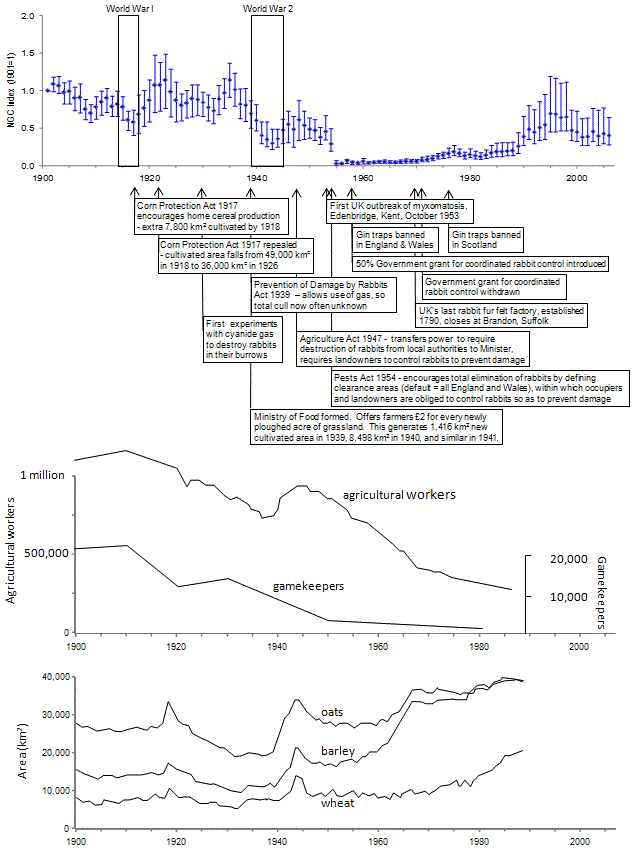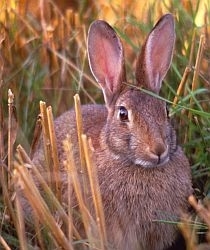Rabbits owe their presence in Britain to man, and have been bound up with man's activities ever since, experiencing the full change of status from a prized and protected commodity to national pest. The numbers of rabbits killed and counted (rabbit bags) have been subject to influence by opportunity, manpower, legislation, incentives, trends in agriculture, market value, fashion, war and rabbit control methods. This is brought home by the fact that certain historical events are clearly discernible in the National Gamebag Census rabbit bag index. We examine below the events that have shaped the trend in rabbit bags since the start of the 20th century (for more general information on current status and recent trends click here).

Index of rabbit bags from 1901 to 2008, annotated with relevant influential events, together with trends in the agricultural workforce and areas planted to major crops over the same period.
The most clearly marked historical event is the introduction of myxomatosis to England in 1953, indicated by an immediate drop in rabbit bags. The subsequent recovery of rabbit bags to roughly pre-myxomatosis levels reflects the gradual adaptation of both rabbit and Myxoma virus to long-term persistence. The two World Wars are also marked by sharp drops in rabbit bags. These occurred despite the sudden inceases in cereal-growing area. Each of the wars not only drained the country's workforce through conscription, but also generated social changes which altered the rural economy irreversibly. There was a drastic reduction in the rural workforce generally, and particularly in gamekeeper numbers, during the 20th century. Gamekeeper numbers in Britain fell from 23,000 immediately before WW1 to about 2,500 at the present time. At the same time, the dangers faced by British shipping meant that domestic production of cereals was strongly encouraged, so there was a marked increase in the acreage of vulnerable crops during each World War.
Early legislation concerning rabbits (starting in 1389) had chiefly sought to establish managed rabbit warrens as an asset in which landowners (or their appointed agents) had exclusive rights to harvest rabbits. The value of rabbit meat and fur remained high for centuries, and relevant legislation continued in this vein up to and including the Larceny Act of 1861. As rabbits became increasingly established outside managed warrens (a process facilitated by enclosure, which introduced countless field edges) rabbit 'ownership' became inseparable from the broader anarchistic challenge of poaching versus the jealous protection of game by landowners. At the same time, tenant farmers who had invested heavily in their crops could suffer considerable loss through rabbit damage. In common law they were entitled to kill marauding rabbits, but this right was often limited or excluded by the terms of their lease.
The Game Act 1831 legalised the sale of game by authorised dealers. This made it easier for a wild rabbit industry to establish during the 19th century, with an estimated 3 million gin traps in regular use. A universal right for occupiers of land to control rabbits (and hares) was finally granted by the Ground Game Act 1880, but paradoxically during the agricultural decline of the late 19th century some landowners/occupiers found that the rabbit harvest produced a welcome secondary income. There was an eager market. Even as late as 1950-53 an estimated 40 million rabbits were sold annually for meat, skins and the fur and felt (hat) trade.
During the early 20th century, the national significance of rabbits as a drain on agriculture was increasingly recognized. In 1951-53 the average impact of rabbits on winter wheat was estimated to be 1.6 cwt/acre in southern and central England. A succession of statutes - the Prevention of Damage by Rabbits Act 1939, the Agriculture Act 1947, and the Pests Act 1954 - disfavoured the use of rabbits as a resource and made their control to prevent damage obligatory for landowners/occupiers. (This obligation continues today, but rabbits are actually controlled on fewer than 50% of properties in England and Wales.) The altered emphasis received strong support from the animal welfare movement, which was appalled by the suffering caused by gin traps, and felt that the destruction of rabbits solely as a pest, by humane methods, was greatly preferable. The use of gin traps was forbidden in England and Wales from 1958, in Scotland from 1976. Several 'humane' models of spring trap (i.e. kill traps) were invented as replacements (8 models and their clones are currently approved), but these are rarely used as the main tools of rabbit control.
The Ministry approach was to promote a combination of gas and ferrets to clear rabbits block-by-block. (If fumigants are used on shooting estates, the number of rabbits killed by this means will be unknown, in which case the rabbit bag may under-represent the total cull and suggest a population lower than it really was.) Initially the emphasis was on drastic action on a voluntary basis, but the Pest Act 1954 gave the Minister power to designate areas within which rabbit clearance was an obligation on landowners/occupiers, and in 1958 the government introduced a 50% grant to assist co-ordinated rabbit control. By 1964, 46% of farmed land in England and Wales (i.e. 60,000 km²) was addressed by 750 Rabbit Clearance Societies. But in 1971 government support was withdrawn, and by 1987, only 75 Rabbit Clearance Societies remained, often with financial problems which meant they made greater use of ferrets than of fumigants. During the 1990s, government research explored cage traps (live traps) and fencing as alternative methods of rabbit control, and in 2009 the Rodenator was approved for the destruction of rabbit burrows. Since the 1940s, the grain market has become global, and Britain has become a net exporter of grain, so arguably the rabbit problem is no longer a national issue, but a decision to be made on the balance of cost/benefit for each individual farmer. However, the obligation to control rabbits remains in place, and failure to control rabbits can affect economics on neighbouring properties, leading to often acrimonious disputes.
The influence of human history on rabbit numbers would of course have been reflected in any monitoring scheme. In recent years we can check the trends apparent in the NGC index against those from other annual schemes, such as the BTO's BBS Mammals. But the NGC is the only scheme with long continuous historical coverage, so we need also to consider the special circumstances of the shooting estates it represents. For rabbits, shooting estates may in fact be atypical of Britain as a whole. Typically, they employ gamekeepers, who can be tasked to reduce rabbit infestations. One might also expect to find traditional harvesting methods - rather than fumigants or fencing - to be more likely on shooting estates, because there is a use for rabbits in the estate economy, if only as dog-food. To some extent there clearly is a balance to be struck between game management as a whole package, and the heavy rabbit control that would be preferred by the farm manager. The control of foxes and other predators by gamekeepers can allow rabbit populations to grow faster and therefore to achieve higher average densities than would otherwise be the case. Trout & Tittensor (1989) found that the rate of post-myxomatosis rabbit increase suggested by NGC data was higher than suggested by repeated MAFF surveys on other ground.
Before the First World War, rabbit bags on individual estates were apparently cyclical (Tapper 1992), with a roughly 8-year period. This need not imply a 'natural' process excluding man: rabbit control is typically responsive to a build-up in numbers, which could itself generate cyclical fluctuations in bags. Across all NGC estates, the gamebag index shows no such cyclicity, either before or after the introduction of myxomatosis in 1951.

Rabbit © Alexis de la Serre
The categorisation of rabbits as an agricultural pest, to be cleared systematically and ruthlessly, clearly failed to achieve its goal. The successive models of voluntary effort and then subsidised effort failed, even when assisted by the unofficial addition of a high-impact disease. In the first decade of the new Millennium, the situation is therefore as follows. Rabbits are again numerous, on shooting estates bags suggest average densities almost as high as before myxomatosis. The UK has a greater acreage of palatable and vulnerable cereal crops than it had pre-myxomatosis, or indeed at the start of the 20th century. Agriculture is intensive and mechanised, and has a fraction of the workforce that it had in the early 20th century. Gamekeeper numbers are a tenth of what they were pre-WW1. The periodic assistance myxomatosis gives in controlling rabbit numbers is now considerably attenuated. Rabbit control is expensive, and effective rabbit controllers difficult to find. The current Technical Note TIN003 by Natural England estimates that farmers are losing about £50 million/year as a result of rabbit damage, and in the current global market, the benefit of rabbit control is something to be judged locally. The emphasis of farming is predicted to be shifting towards increased food production, so it will be interesting to see how this changes in the next few decades.
- Trout,R.C. & Tittensor,R.M. (1989). Can predators regulate wild rabbit (Oryctolagus cuniculus) populations in England and Wales? Mammal Review 19: 153-173.
- Tapper,S.C. (1992). Game Heritage: An Ecological Review from Shooting and Gamekeeping Records. Game Conservancy Ltd, Fordingbridge